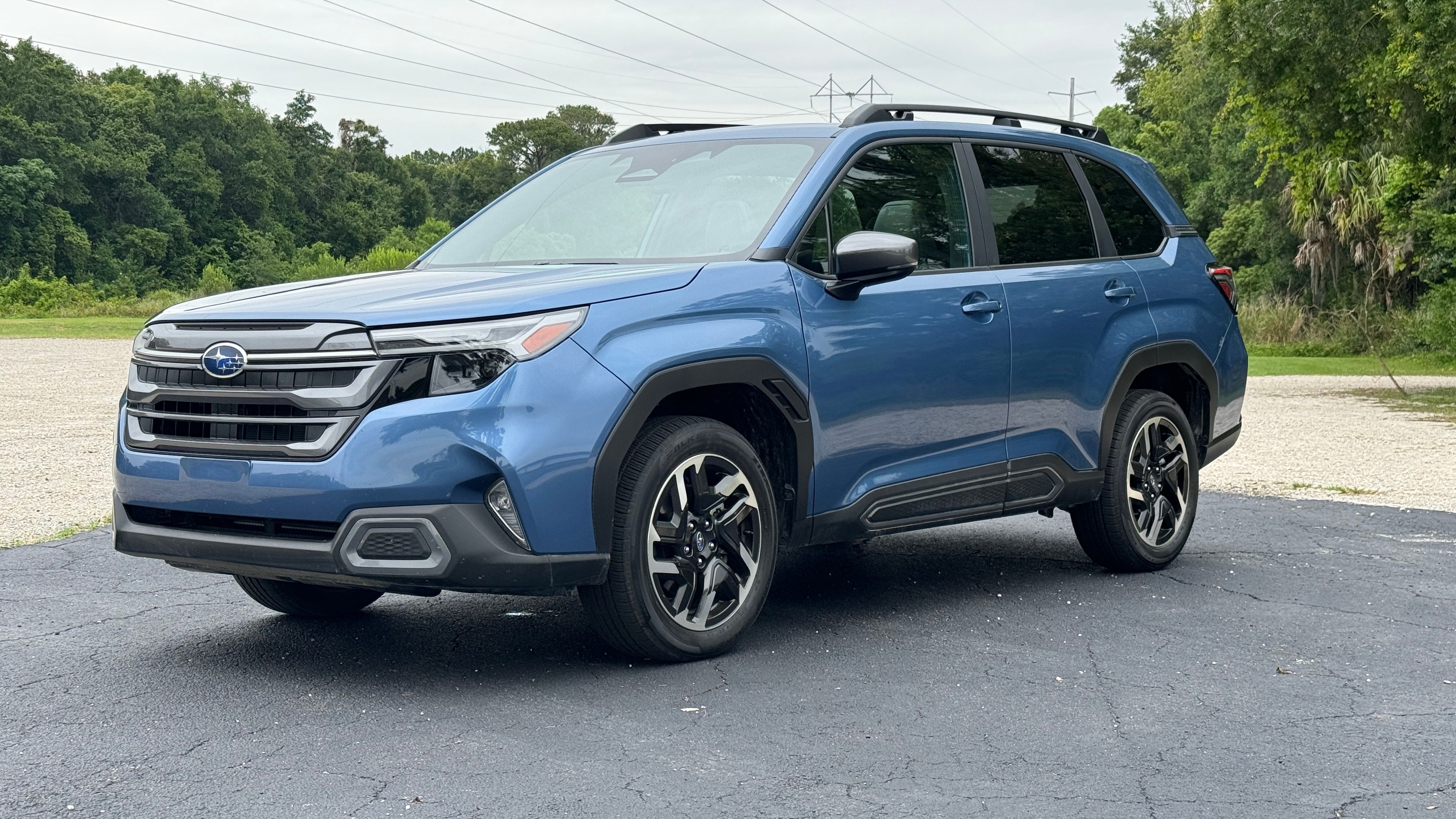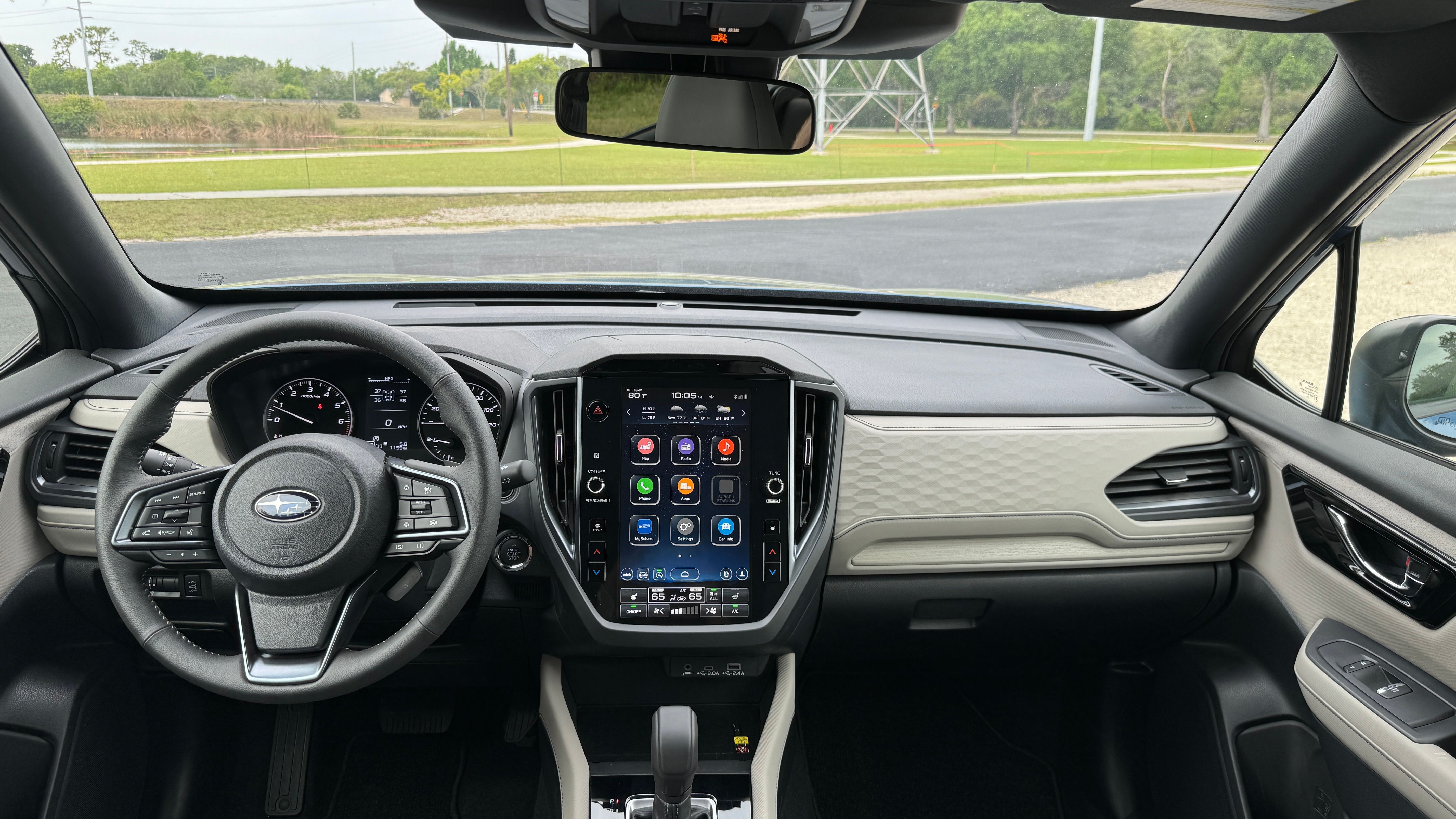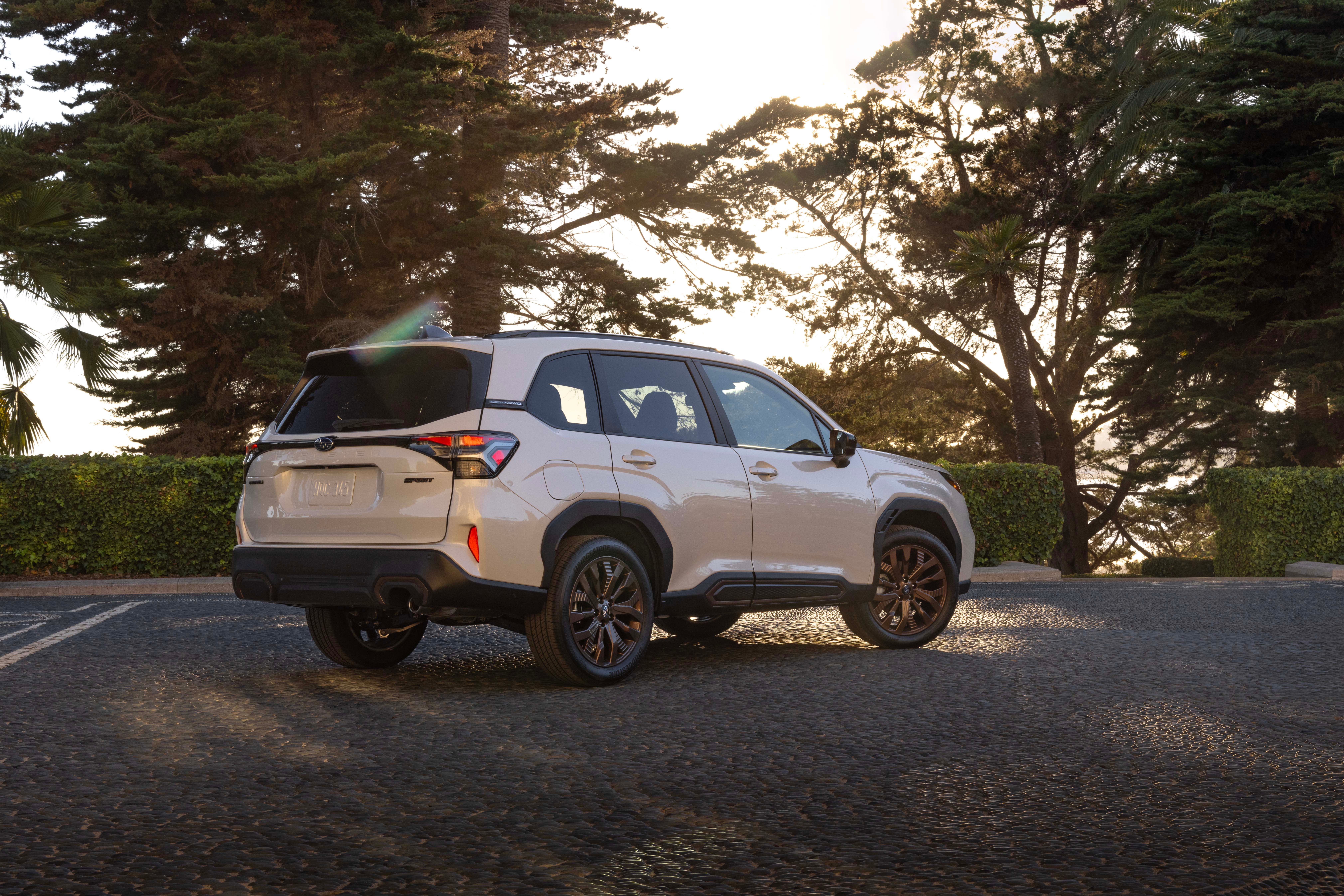With a popular product like the Subaru Forester, it’s best not to shake up the formula too drastically – no-one wants to alienate loyal buyers who already love what’s being offered. Despite being called an “all-new” sixth generation, the 2025 Forester shares a lot in common with last year’s model. Since it was starting to feel a little old, it gets various styling and technology improvements to bring it more in-line with the rest of the Subaru lineup. Even with popular rivals like the Mazda CX-50 and Honda CR-V vying for customers, the Forester managed to sell 152,000 units in 2023, making it one of Subaru’s top three bestsellers, alongside the Crosstrek and Outback.
Under the hood sits a carryover boxer four-cylinder engine that actually produces less horsepower but more torque than the previous model year. Subaru announced that a hybrid powertrain will join the 2026 lineup, but few details are known about it as of this writing. What we have then is a fairly straightforward updated Subaru to evaluate; no frills, and no crazy plot twists.
Subaru sent us a 2025 Forester Limited to review – a mid-level trim that should be more representative of what the average consumer will purchase. Are Subaru’s changes enough to keep Forester buyers loyal, and are they enough to attract new customers to the brand? We found out.
Exterior: Simplicity and Anonymity
Since the Forester’s inception back in 1997, the model has always maintained a distinct shape and appearance. The Forester is meant to look like a tall station wagon, which the current model continues. It’s longer than other compact crossovers like the Toyota RAV4, but the wheelbase is similar. It’s not significantly taller than its contemporaries, but the wagon-like shape gives it a more open greenhouse that yields more light in the cabin. As standard, the Forester boasts 8.7 inches of ground clearance, which is better than most of its rivals.
Base and Premium trims ride on 17-inch wheels, while the Limited gets 18-inch wheels that look slightly more impressive. Buyers who want the most visually appealing Forester should opt for the Sport or Touring trims, both of which have 19-inch wheels filling the arches. The Sport is paired with bronze wheels that look similar to a Honda Trailsport model, while the Touring gets two-tone black and silver wheels. Subaru offers nine mostly subtle exterior colors, including our tester’s Horizon Blue Pearl, which is among our favorites. River Rock Pearl (a type of gray) is the only premium paint, priced at $395.
We jokingly mention how the Forester Sport looks a bit Honda-ish to us because the whole design seems a bit generic to our eyes. It could just as easily come from Ford or Honda, and lacks any distinct Subaru DNA to help it stand apart. The updated fascia and LED headlights are inoffensive, but we wish Subaru would have taken a bolder step with the design language; the Forester looks like any other crossover on the road, and is unlikely to leave an impact visually.
Interior: Catching Up With The Times
Aside from the BRZ sports car, the Forester was the last Subaru model to get the company’s latest interior layout and technology. The 2025 refresh rectifies that. The base trim now gets dual seven-inch touchscreens, while every other trim comes with an 11.6-inch Starlink infotainment system that is vertically oriented. While not our favorite infotainment system in the business, Starlink remains simple to use, so it won’t be a shock to outgoing Forester owners when they hop in to use it for the first time. Apple CarPlay and Android Auto are now wireless so long as you get the 11.6-inch screen and built-in TomTom navigation is also available.
As you’d expect from Subaru, the Forester’s interior feels well-built but somewhat utilitarian. Durable surfaces should stand up to wear and tear, which feeds into Subaru’s pet-friendly image. The Forester Base comes with a gray cloth interior, while the Premium upgrades the premium gray or black cloth. The Sport trim includes gray StarTex (fake leather) and the Limited comes with the real stuff in either black or a lovely two-tone gray (pictured). Stepping all the way up to the Premium brings black or brown leather with heated and ventilated seats, so technically, there’s something for everyone.
Step into the 2025 Forester and you are treated to what is possibly the best greenhouse (the glass area above the fender line) in any new vehicle. So much sunlight enters this cabin, and the outward visibility is top-notch. Subaru offers what it calls a panoramic moonroof that barely stretches into the back seat; it’s either the smallest panoramic roof in the industry, or one of the largest regular moonroof designs, depending on your outlook. Whatever you call it, the area that opens is enormous, letting in a ton of fresh air.
Practicality: Airy and Spacious
The Forester’s tall, airy shape yields plenty of space for people and their equipment. EPA passenger volume is rated at a substantial 110.8 cubic feet, which stacks up favorably against the compact crossover segment’s best-selling models like the RAV4 and CR-V. Headroom and legroom are impressive for the segment in the front and the rear, making the Forester a great option for space-conscious buyers.
|
Subaru Forester Interior Dimensions vs. Rivals |
||||
|---|---|---|---|---|
|
Models |
Headroom Front | Rear |
Legroom Front | Rear |
Hiproom Front | Rear |
Cargo Space |
|
Subaru Forester |
40 – 41.2 | 37.7 – 39.6 inches |
43.3 | 39.4 inches |
54.7 | 53.7 inches |
29.6 – 74.4 ft³ |
|
Honda CR-V |
38.2 – 40 | 38.2 inches |
41.3 | 41 inches |
55.6 | 52.6 inches |
39.3 – 76.5 ft³ |
|
Toyota RAV4 |
37.7 | 39.5 inches |
41 | 37.8 inches |
54.3 | 47.7 inches |
37.6 – 69.8 ft³ |
Subaru says the Forester has 29.6 cubic feet of space behind its second row seats, or 74.4 cubes with those seats folded. The CR-V has more in both measurements and although the RAV4 is smaller overall, it has a larger area behind its rear seats. Buyers who need more space should consider upgrading to the larger Subaru Outback, while empty nesters who want a smaller vehicle may enjoy the Crosstrek.
Powertrain: Carryover With A Hybrid Coming
Subaru currently sells the Forester with a single powertrain: a 2.5-liter boxer four-cylinder producing 180 hp and 178 lb-ft of torque. Most automakers increase power in a new generation, but the 2025 Forester actually drops by two horses compared to the outgoing model. This was done in an effort to improve torque by two pound-feet and also improve the torque curve. In other words, the new model now requires fewer revs to get going, which will make it feel smoother and less stressed during acceleration.
All Forester models send their power out through a Lineartronic continuously variable transmission to Symmetrical all-wheel-drive. Premium trims and above get paddle shifters to control eight simulated gear ratios, a feature we doubt many Forester owners will ever use. We do like how the CVT shifts ratios during acceleration to avoid the typical drone associated with this transmission type. Fuel economy is average for the class at 26/33/29 MPG city/highway/combined, dropping to 25/32/28 in the Sport or Touring trims with the 19-inch wheels.
A hybrid model is coming and should offer superior fuel economy, but no other details are known about it. Subaru will build the Forester Hybrid in the US at its Lafayette, Indiana plant alongside the gas model starting in 2026.
Driving Impressions: Quieter Utility
Though the Forester was in no way designed to be sporty, it is quietly fun to drive, like most Subaru models. Subaru always engineers some handling prowess into its cars, and we are always surprised by how athletic they feel even though they are not designed for an enthusiast audience. The steering is well-weighted, though the suspension rolls significantly through the corners with limited grip from the tires. We also felt too high up in the seating position with no ability to get low enough, a detail that some owners might prefer.
Subaru’s biggest improvements to the driving experience are things that you will only notice by listening closely. There was a concentrated effort to make the cabin quieter through various means. There is more welding in the chassis and sound deadening throughout the vehicle, resulting in a 39% noise reduction. We instantly noticed the lack of wind, road, and engine noise at city and highway speeds, something we complained about in the previous Forester. Outgoing Forester owners looking to upgrade should be happy with this improvement.
Pricing & Verdict: Affordable AWD
Starting at $29,695 for the Base trim (excluding $1,395 destination), the Forester is among the most affordable ways to get standard AWD in the compact crossover segment. There are some rivals that undercut Subaru on price, but very few come with AWD as standard. We’d recommend at least stepping up to the Premium trim for $31,995 to get the larger screen, keyless access, heated front seats, the panoramic moonroof, and an available power liftgate and blind spot detection. The 2024 Wilderness trim will be sold alongside the 2025 lineup, but Subaru has no confirmed plans to create a Wilderness trim for 2025.
The Sport trim costs $34,495, adding 19-inch bronze wheels, blind-spot detection, StarTex upholstery, and more. While less visually interesting, the $35,995 Limited trim gets real leather and power driver and passenger seats. A $1,600 package adds rear automatic braking, a Harmon Kardon premium audio system, and built-in navigation. We’d personally skip the $39,995 Touring trim since there are more luxurious options in this segment for a similar price. If you want heated front and rear seats, ventilated front seats, and a 360-degree camera, this trim is the only way to get those features.
Subaru doesn’t break any new ground with the 2025 Forester, but it improves on an already beloved formula. This update may not attract hoards of new buyers to the brand, but it will certainly appease current customers who want better tech and a quieter cabin. The upcoming hybrid should give Subaru a broader appeal, since this model will combine everything we love about the Forester with more competitive fuel economy.






